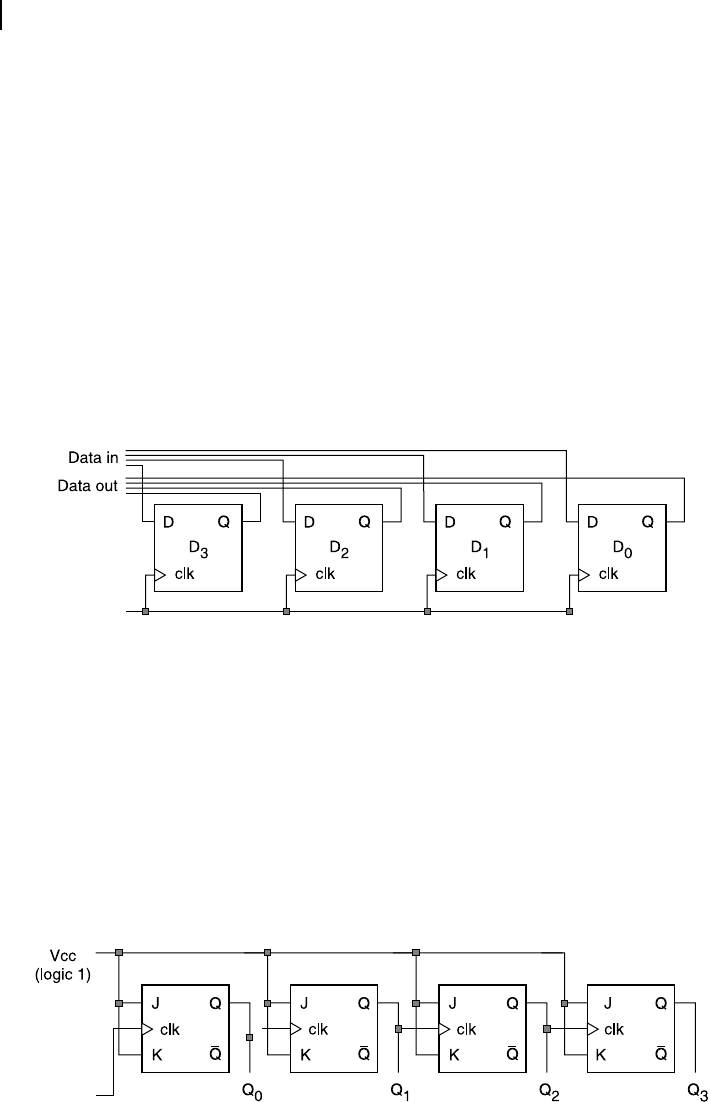
Fundamentals of Digital Logic Circuits 45
However, it is interesting to note that if both J and K are 1, then the output Q keeps on inverting itself
continuously, generating a clock-like signal. This is indicated by toggle in Table 3.6.
J K Q
0 0 Q
old
0 1 0
1 0 1
1 1 Toggle
Table 3.6 J-K flip-flop
3.6.7 T Flip-Flop
A derivative of J-K ip- op is the T ip- op. Here ‘T’ stands for toggle. Figure 3.21 illustrates its circuit
and symbol.
T ip- op is derived from J-K ip- op by connecting its inputs J and K together as shown in Figure
3.21 (a). This common input is designated as T. If T is 0, then clock transitions would not change the
previous output of T ip- op. However, if T input is pulled up to 1, then the output Q would be Q¯
old
.
3.7 REGISTERS AND COUNTERS
Two important application areas of ip- ops are registers and counters. Registers are extensively used
in all processors to store and manipulate data. Counters are also used within processors for various rea-
sons. In this section, we take a quick review of both.
Figure 3.21 T flip-flop (a) Circuit and (b) Symbol
Figure 3.20 J-K flip-flop (a) Circuit and (b) Symbol
M03_GHOS1557_01_SE_C03.indd 45M03_GHOS1557_01_SE_C03.indd 45 4/29/11 5:02 PM4/29/11 5:02 PM

46 Computer Architecture and Organization
3.7.1 Registers
Registers are widely used within processors for temporary data storage. Generally, they are 8-bit or
16-bit wide, depending upon the demand of the system. Essentially, they are made from D- ip- ops,
inter-connected in parallel, as shown in Figure 3.22 . In this example, circuit of 4-bit register, four D
ip- ops are inter-connected so that the same clock signal drives all four of them. Separate data in and
data out lines are provided through D inputs and Q outputs. The input data would be latched with the
clock input and would immediately be available at the output. If any separate write signal is necessary,
it may be ANDed with the clock signal.
Another type of register, known as shift register , is applied to store data and accept or output only
1-bit at a time. These shift registers are widely used for serial data transmission, where a byte of data to
be broken down bit by bit and to be transmitted out. Shift registers may be derived from a set of D ip-
ops arranged in cascade con guration by connecting the D input of one ip- op with the Q output of
the previous ip- op. In this case also, the same clock signal drives all D ip- ops.
3.7.2 Counters
Multi-bit counters are frequently used in computer circuits for binary counting for various purposes.
Two example cases of application of counters are program counters and timer counters. Just like regis-
ters, counters are also 8-bit or 16-bit wide, depending upon the speci c system requirements.
Figure 3.23 presents the construction of a 4-bit asynchronous ripple counter, constructed from four
J-K ip- ops. In this case, the toggle property of the J-K ip- op is utilized. Observe that both J and
K inputs of each J-K ip- op are connected with Vcc to input logic 1 for both inputs. Referring to
Clock
Figure 3.22 Schematic of a 4-bit parallel register using D flip-flops
Clock
Figure 3.23 Asynchronous ripple counter using J-K flip-flops
M03_GHOS1557_01_SE_C03.indd 46M03_GHOS1557_01_SE_C03.indd 46 4/29/11 5:02 PM4/29/11 5:02 PM
..................Content has been hidden....................
You can't read the all page of ebook, please click here login for view all page.
